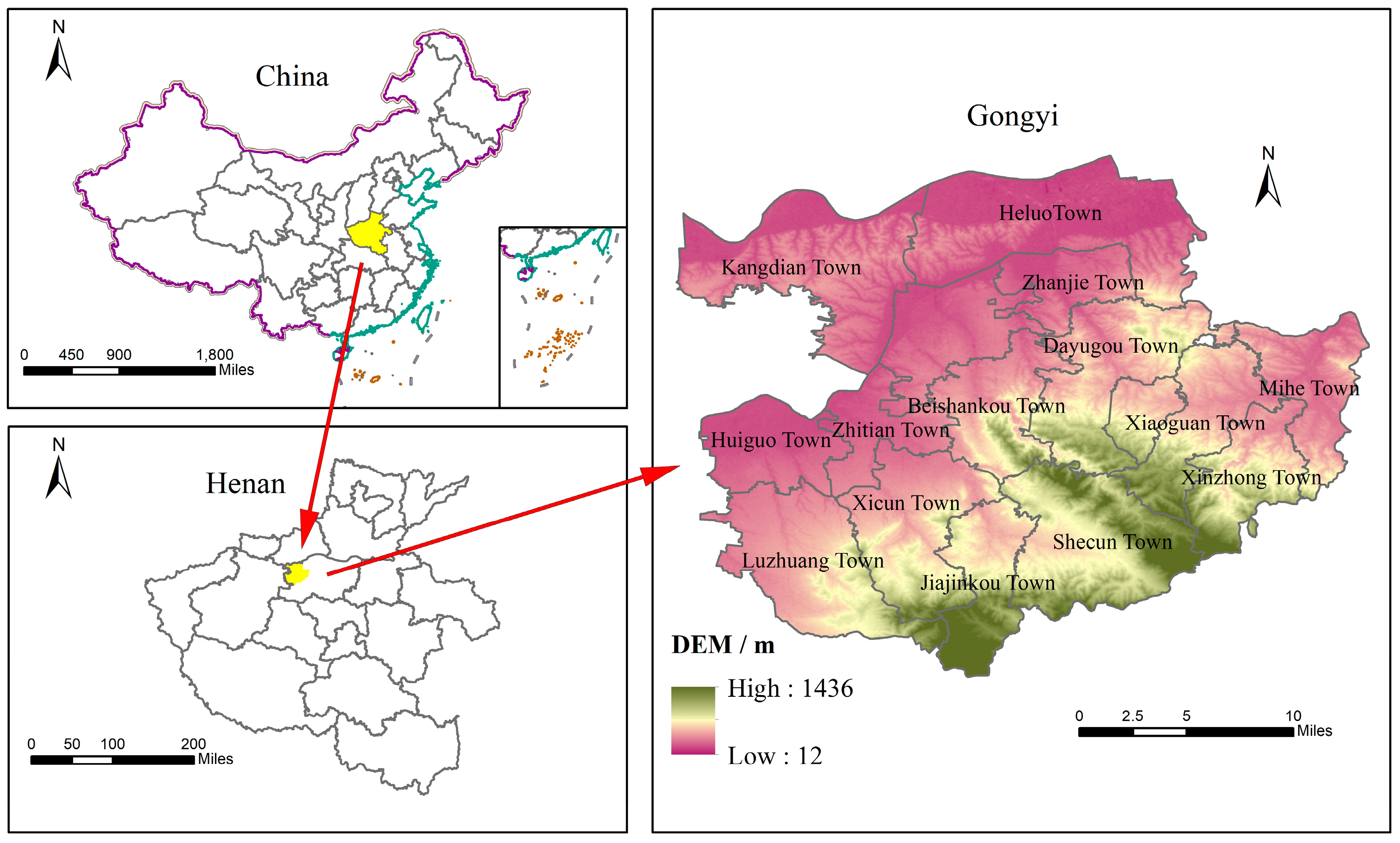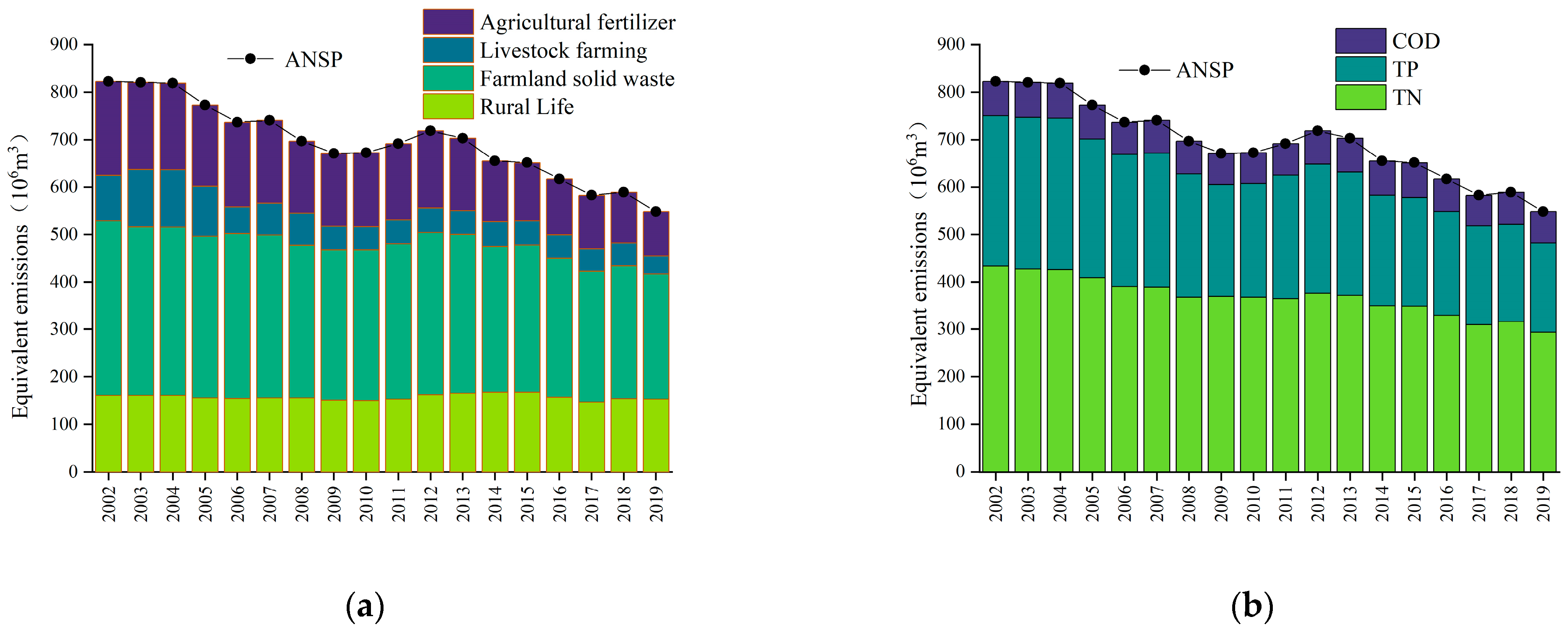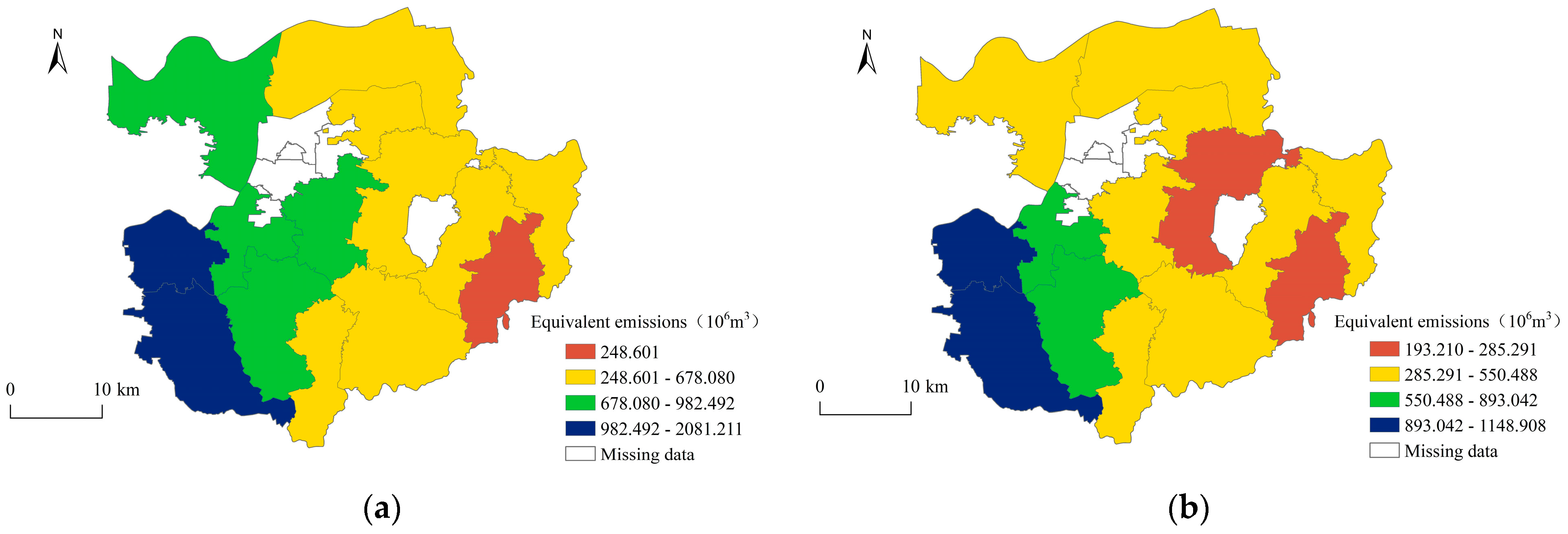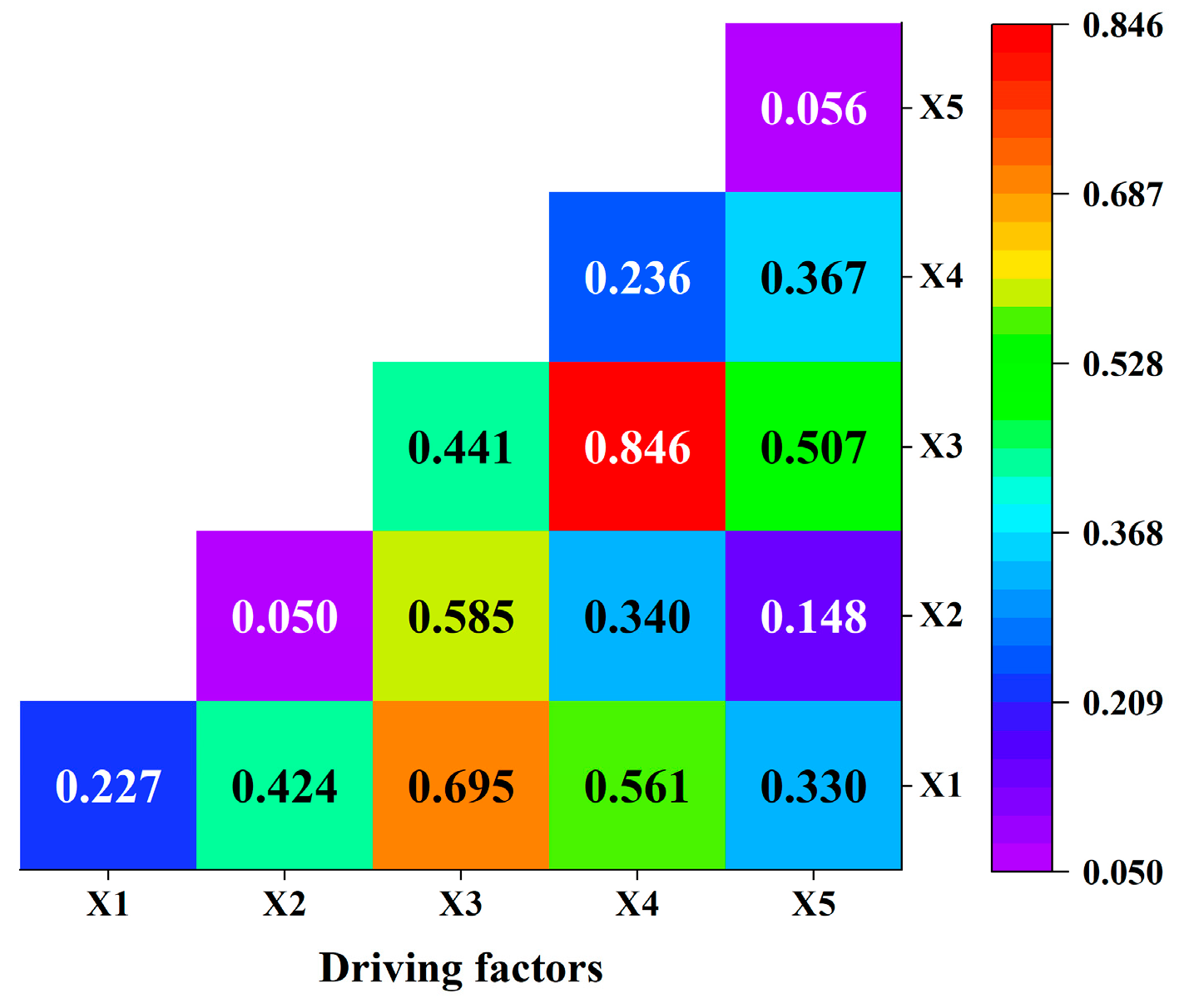1. Introduction
Agricultural non-point source pollution (ANSP) is prevalent globally, affecting 30% to 50% of the earth’s surface [
1]; therefore, the study of ANSP has been a hot topic of academic research. Since the implementation of China’s reform and opening-up policy in 1978, industrialization has accelerated technological progress in agricultural production and large-scale mechanized agricultural production has been realized, leading to a substantial increase in agricultural production efficiency [
2]. China’s agricultural economy has progressed remarkably, with the production of China’s major agricultural products increasing exponentially or tens of times, most of which are among the highest worldwide, with grain, oilseeds, and meat all ranking first worldwide [
3]. However, the great achievements of agriculture have come at the cost of environmental losses. Since the agricultural production system is still a crude production model with high inputs and outputs [
4], there are many misconducts in agricultural production. For example, the drenching with pesticides and fertilizers, the excretion of livestock and farming, and the uncontrolled discharge of rural household waste. A large amount of pollutant emissions is generated in this process, especially ANSP [
5]. This not only gradually erodes the agroecological environment but also has a substantial impact on food security [
6,
7].
ANSP can damage the intrinsic structure of agricultural soils and accelerate their nutrient loss, resulting in increased soil consolidation; it can also lead to a decrease in the quality of agricultural products, such as excessive nitrate content in vegetables [
8,
9]. When the problem of ANSP is serious, it will lead to the phenomenon of the eutrophication of water bodies, destabilizing underwater ecosystems, and threatening the safety of potable water for humans and animals [
10]. Therefore, increasing studies have been devoted to ANSP reduction strategies to achieve healthy and sustainable agricultural development.
Most studies that investigated ANSP have focused on units at the watershed [
11], provincial [
12], and municipal [
13] levels, neglecting studies on small town areas. A small town is the extent of the built-up area in which an established town is located. It is the administrative, economic, and cultural center of the rural area, as well as the smallest administrative unit in China [
14]. With the rapid development of industrialization and urbanization, big cities have been forced to balance the interests of economic development and the ecological environment, increasingly enforcing strict environmental protection laws and regulations, while small towns are relatively weak and lax in environmental protection. Thus, major polluters in big cities gradually move to small town areas, and some old technologies that were eliminated after technological upgrades in big cities are then transferred to small towns [
15]. However, compared with large cities, small towns have a weak economic base and poor environmental management capacity, leading to serious ecological damage in small town areas [
16], especially serious problems with ANSP.
Compared with point source pollution, ANSP is characterized by decentralization, randomness, extensiveness, difficulty in monitoring, and lagging, making it a challenge to measure [
17,
18]. Model simulation is a common method for monitoring and assessing ANSP and existing models can be divided into physical and empirical models. Physical models are constructed based on the intrinsic mechanisms of ANSP formation, simulating the process of pollutant generation and transport; then, ANSP loads are calculated through mathematical models. Physical models mainly include ANSWERS [
19], SWRRB [
20], SWAT [
4], HSPF [
21], and other models, which are mostly applicable to watershed-scale studies [
22]. The empirical model is based on the data of each pollution unit and establishes the relationship between pollution units and ANSP emissions through multivariate linear correlation analysis; it then calculates the ANSP load of different units. Subsequently, the ANSP loads of each unit are summed to estimate the total ANSP emissions in the entire study area [
23]. The empirical models mainly include the output coefficient model and non-point source inventory method. Compared with physical models, empirical models require less data and are more commonly applied [
24,
25]. Existing studies have shown that the application area of output coefficient models can be either a watershed or an administrative unit [
11].
In the study of factors influencing ANSP, more scholars have focused on the impact of economic development on ANSP and the most frequently applied model is the Environmental Kuznets Curve (EKC) [
26,
27]. Most existing studies support the EKC hypothesis of ANSP [
28,
29] and the relationship between ANSP and economic growth has an inverted “U-shaped” distribution in most cases [
30], where the pollution level increases with economic growth at low income levels and decreases with economic growth at high income levels. A small number of studies have also found that some regions conform to the “N” or inverted “N” distribution [
29,
31]; at the same time, some scholars have questioned the EKC [
32]. In addition, some studies have used the logarithmic mean Divisia index factor decomposition method to deconstruct the effect of economic development on ANSP into different effects [
33,
34]. For example, Liang et al. [
35] decomposed the effect of economic development on ANSP into scale, structural, and pollution reduction effects; Wu et al., [
36] referring to the proposed IPAT model, decomposed the impact of economic growth on environmental pollution into three aspects: population size, affluence, and technical level. There are also studies that analyze its association with ANSP in terms of natural factors [
37], financial development [
38], and labor quality [
12] as well as those that analyze their effects on ANSP from micro perspectives such as farmers’ behavior [
39] and willingness [
40].
The spatial spillover effect of environmental pollution refers to the first law of geography—the geographical proximity effect—which leads to the rapid expansion of pollutants with easy mobility to neighboring areas or even farther away, manifesting as a spatially contagious relationship [
41,
42]. ANSP is a “spillover” pollutant with a strong spatial spillover effect [
42]. Existing studies on the influencing factors of ANSP are usually divided into different spatial units based on administrative boundaries, assuming that each regional unit is an independent individual, ignoring the spillover effects of ANSP between regions [
43]. In contrast, the spatial econometric model assumes the existence of a spatial correlation among regions and considers the influence of surrounding areas on the study area, which can more fully reveal the effect of each influencing factor on ANSP [
12].
Therefore, this study took Gongyi City, a typical representative of small towns under the background of rapid industrialization, as the research area. Based on the panel data set of 14 small towns in Gongyi City from 2002 to 2019, the non-point source inventory method that is more suitable for this study area was selected as the calculation method of ANSP load in Gongyi City. Furthermore, based on the spatial econometric model and the EKC hypothesis, the impact of various influencing factors on ANSP was empirically explored by selecting factors such as the degree of industrialization. At the same time, the driving factors behind the spatial stratification heterogeneity of ANSP, as well as the interaction between factors, were analyzed by using factor detection and interaction detection in geographical detectors. The research results can provide theoretical and practical guidance for the coordinated development of agricultural sustainable development planning in small town areas, thus enriching the existing research contents of regional development and economic geography.
The main contributions of this study are as follows: (1) The EKC model was extended to the spatial Durbin model to empirically explore the nonlinear relationship between industrialization and ANSP. Most existing studies directly assume that there is a linear relationship between industrialization and environmental pollution [
44]. Given that industrialization is at a new stage of development from “high speed” to “high quality” [
45], the impact of industrialization on ANSP may have a nonlinear relationship. (2) Most of the existing studies are based on traditional econometric models to analyze the factors affecting ANSP, ignoring the impact of possible spatial spillover effects and spatial heterogeneity of ANSP on the model estimation results [
46,
47]. In this study, the spatial spillover effect and spatial heterogeneity of ANSP were tested and estimated using spatial econometric models and geographical detectors.
4. Discussion and Recommendations
This study examined the evolution of ANSP and the factors influencing it in small town areas in the context of rapid industrialization from a geographic perspective. Although some scholars have already conducted related studies, this study still had some innovative features. First, in comparison to Mahmood et al. [
59] who suggested that industrialization would lead to increased environmental pollution, this study showed an inverted “U” shaped EKC relationship between industrialization and ANSP in small towns in a typical area of ANSP in China. This study is helpful to clarify the relationship between industrialization and ANSP in small towns with contradictory agricultural development and to extend the boundary of environmental Kuznets theory to a certain extent. Furthermore, compared with the traditional regression model used by Zhang et al. [
26] to analyze the influencing factors of ANSP, this study analyzed the influencing factors of ANSP in terms of both spatial spillover effects and spatial stratified heterogeneity, which was conducive to improving the credibility of the results. Meanwhile, it was found that affluence, population size, and cropping structure positively contributed to ANSP; these findings are consistent with those of existing studies [
35,
36,
38]. The spatial spillover effect of industrialization on ANSP was not significant, which is likely due to the small scale of the study area in this study and the low exchange of resource factors between regions. The results of this study can provide a scientific basis for the prevention and the control of ANSP in similar rapidly industrializing small town areas and play a supporting role in sustainable agricultural development.
Based on the results of the empirical analysis, combined with the basic ideas of agroecological economics and sustainable agricultural development, the following suggestions for the prevention and control policies of ANSP are proposed.
(1) Control at the source to prevent the risk of ANSP is necessary. Temporally, ANSP in Gongyi City from 2002 to 2019 showed a zigzagging downward trend, indicating that the agricultural development in Gongyi City was positive; however, there are still some inefficiencies and environmental losses and there is substantial room for agricultural pollution reduction. From the perspective of pollution sources, ANSP emissions mainly come from farmland solid waste and rural life, livestock and poultry breeding, and agricultural fertilizer; pollutant emissions were mainly in the order of TN > TP > COD. Thus, real-time prediction and assessment of production and discharge sources of pollution is crucial. This will also improve the effective use of agricultural solid waste storage and processing equipment, promote the updating and upgrading of relevant technologies, and enhance the standardization of rural living environments via targeted pollution risk mitigation.
(2) Strengthening cooperation for mutual benefits and creating “eco-efficient” situations is key. According to the spatial econometric model results, ANSP shows a significant spatial correlation and clustering distribution pattern. Therefore, policymakers should fully consider the spillover effect of ANSP when formulating policies, eliminate local protectionism, conduct comprehensive planning from the perspective of regional integration, establish a complete agricultural policy linkage mechanism, and strengthen inter-regional agricultural production resource sharing, exchange, and cooperation.
(3) Increasing the research, development, and promotion of green agricultural production technologies will continue to be important. From analyzing the impact of industrialization on ANSP, we can see that the improvement of agricultural green production technology can effectively promote an early crossing of the inflection point of the EKC. Technological innovation is the only path for China’s ongoing agricultural development. In terms of China’s agricultural growth, although the contribution of science and technology to agricultural development has reached 42%, it is still far behind that of other developed countries (which tend to be closer to 70%). Therefore, we should increase investment in agricultural science and technology innovation and vigorously develop and promote new resource-saving and environmentally friendly agricultural technologies. For example, by promoting soil testing and fertilization techniques, encouraging farmers to apply more organic fertilizers, developing new pesticides such as bionic pesticides, and promoting biodegradable agricultural films. Furthermore, as China is limited by farmers’ education levels, learning abilities, and production input levels, there is a greater need to develop simple, easy-to-operate, and low-cost agricultural green production technologies.
In general, this study has some limitations. First, the non-point source inventory method was chosen for the measurement of ANSP, which means the research results may deviate from the actual situation. Second, the spatial Durbin model was used for the influence factor analysis, which lacked consideration of local spatial regression models. Therefore, in future studies on ANSP, field ANSP measurements should be increased as much as possible and local spatial regression models should be tried in the research method, so as to improve the accuracy of the research conclusions.









